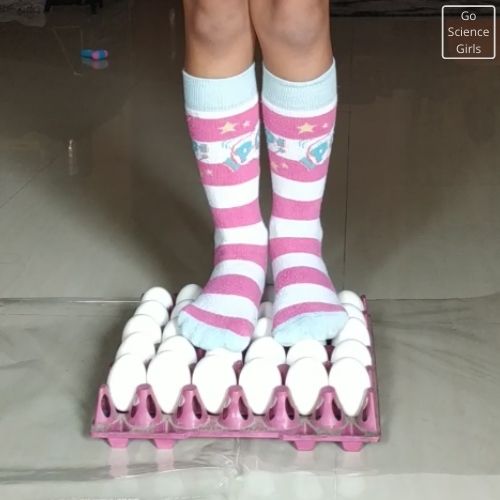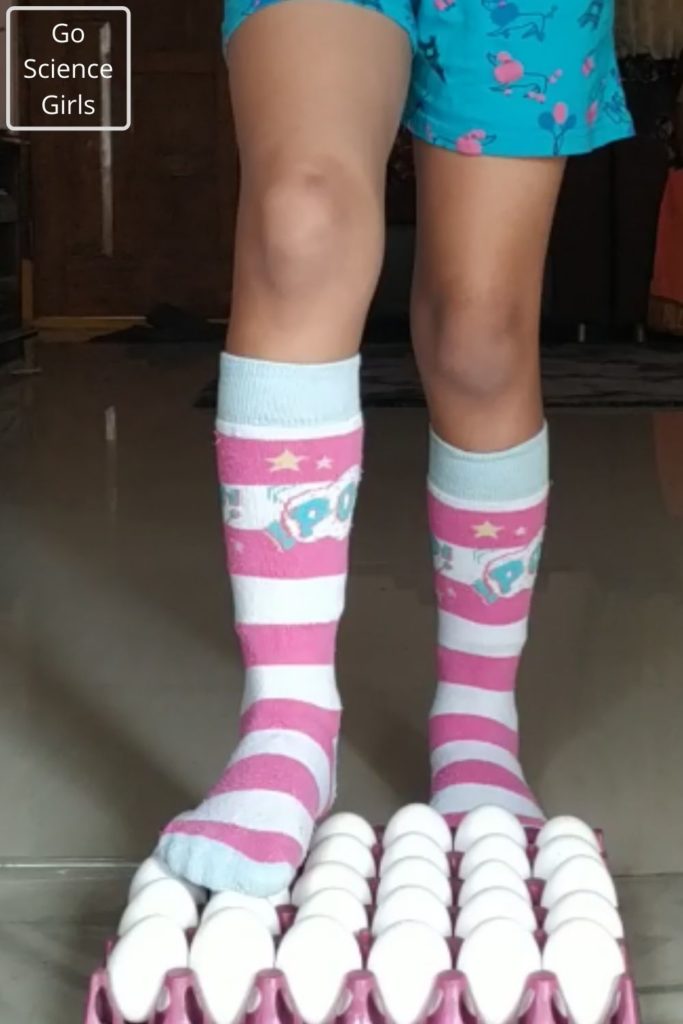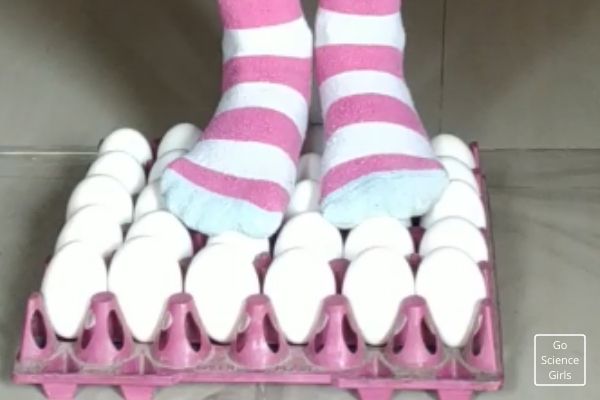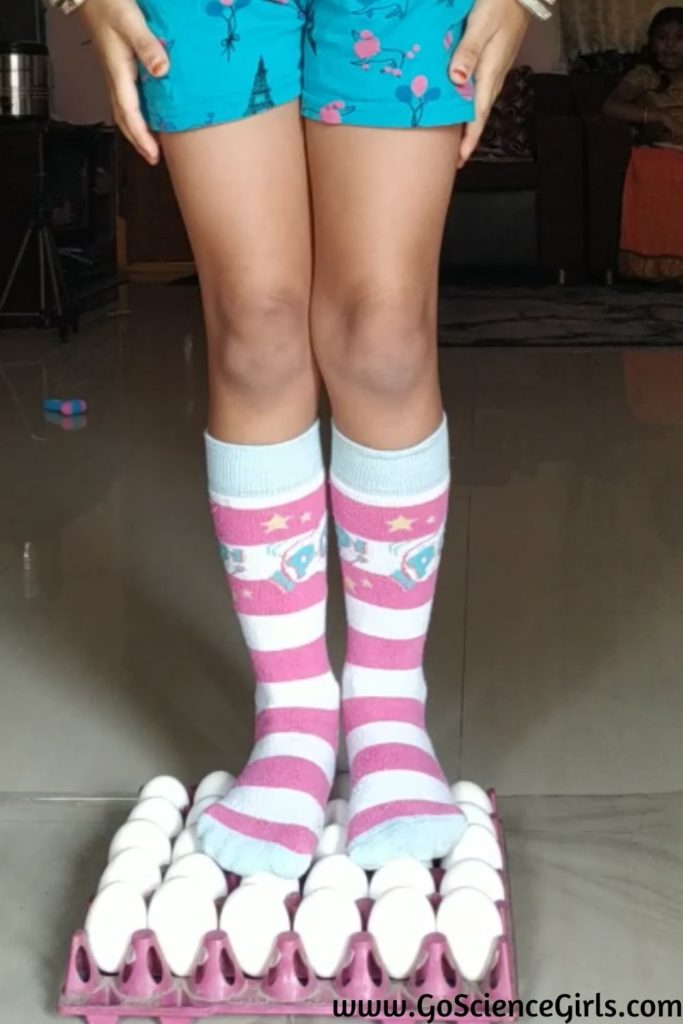The phrase “Walking on Eggs” sounds crazy because we have mind-set that eggs are fragile.
But today, we are going to walk on eggs, which debunks the idea that eggs are fragile.
This is one of my favorite egg science experiment.
Walking on Eggs Science Activity
Before you do this experiment in front of your friends and family, you can give them a challenge of ‘walking on eggs without cracking them’!
Ask your audience to get prepared for the shocking results!
Hahahaha! Because you are going to change their opinion after investigating this activity.
Also, exploring this science experiment reveals two things for children to learn. They include: how strong eggs really are and how pressure distribution works in this experiment.
Hence, this simple activity is perfect for children to investigate during their free time and anytime of the year.

Objectives: To investigate the following:
1) The strength of the egg shells
2) To know the strength of the arches or domes
Time Required: Just a few minutes
Age: Perfect for any age group children! For 4-6 grade children, it is a good classroom lesson to learn simple science concepts like pressure distribution, shapes, strength, etc.
Walking on Eggs Science Experiment in Detail
Preparation
Coming to the activity, we need to do a little preparation to avoid messy work in our experiment area.
As this experiment can become bit messy if you are not careful, I would suggest to put a plastic sheet or put down a tarp underneath the egg cartons.
Better yet, perform this experiment outside on a flat and smooth surface!
How many egg cartons are required?
I believe this experiment can be tried with 2 dozens of eggs. In our trial, we had around 30 eggs just to be on safer side.
You can choose to try two different cartons for two legs or you can try a large carton like us for both the legs.
If you are able to get a large carton of eggs, you can even walking couple of steps instead of just standing on the legs.
Place the egg cartons one by one in a straight line and make sure the egg carton boxes are combined by their ends.
Keeping in mind that children are going to walk on the walk way of egg cartons, build shorter walkways.
Shorter walk ways makes children comfortable while experimenting such that we can avoid unnecessary panic during experiment.
Now we are all set to do the walking on egg science activity. Kids are now will be very excited about what they are going to do and can’t wait to get started! Let us begin the fun activity!
What you need
We require very few supplies around the home that include:
1) Enough eggs in a stable carton (larger eggs work better)
2) Plastic sheets or newspaper or a garbage bag laid on the floor to manage the unexpected mess and to protect our floor from mess)
3) Towel (To wipe any gooey feet before children ran off to the clean surface)
4) Socks (Optional)
5) A lovely assistant to help steady your kids weight – An that’s you isn’t it?

Instructions to Perform the Walking on Eggs Science Project
Step-1: Open your egg cartons and check whether there is any cracked egg. Make sure there is no single egg in the carton is cracked or flawed in any way.
Step-2: This is the important step which needs a little care and adult supervision.
In this step, we are going to separate the center part of the egg cartons to make sure the eggs cartons are in right position to walk.
You can use kitchen or Stanley knife to cut the egg cartons and adult supervision is required while cutting the egg cartons.
Step-3: Generally, eggs come in oval shape with two ends: One end is pointy while the other end is rounded.
So, our next step is to arrange the eggs in the carton boxes in the position either pointy end or rounded end facing up.
This is another crucial step because it safeguards a stable surface area for you or your child’s body weight to spread over.
Step-4: In order to avoid the mess, I suggest to place the plastic sheet or garbage bag or any cloth on the floor.
And then place the cartons over the sheet (we used plastic sheet) and make sure the walk way is consistent.
Once you are done with this step, fill the egg carton boxes with eggs as directed in the step-3.
Step-5: Place your foot carefully on to the eggs and if required take your assistant’s help to balance your foot on the eggs in correct way.
Placing the foot in right way i.e. evenly on to the eggs gives you a comfortable walk on the eggs.
Step-6: Following the same rule mentioned in step-5, place your second foot carefully on to the other tray places adjacent.
You can take help of some other person to balance yourself while placing your feet on the eggs.
Step-7: Now you are steady standing on the eggs. Do not move or shift your body weight because it may result in cracking the eggs.
Step-8: That’s it! You are all set to walk on the eggs without breaking!

What actually is happening when you walk on eggs?
Eggs are naturally shaped like a three-dimensional dome or arch shape!
This shape provides enough strength to the eggs to hold heavy weight without breakage.
Because they are the perfect structures and one of the strongest architectural forms with internal strength.
The dome or curved shape of the eggs provides pressure distribution evenly all over the shell and makes the egg shells very strong.
Science Involved
The oval shaped eggs create an arch on both sides that is rounded and pointed ends.
So, when you place your body weight directly on to the eggs, the force or pressure is evenly spread.
This shows us that the pressure of the body weight is not concentrating at single point.
That is the reason, the dozen eggs take your body weight evenly and support you to walk without cracking the eggs.
However, if you hit the egg against something hard it will give crack immediately and easily.
Because the egg shells do not withstand the uneven forces which keeps the whole weight at one point making the egg break.
That is the reason when you crack an egg, it breaks easily because you are concentrating force at one point.
Note: The design of the egg carton box also helps and takes some role in managing comfortable walk on the eggs.

Science Fair Connection
Walking on eggs science experiment does not make a good science fair project. But you can make it as a good science fair project by changing the variables and other supplies.
Do you have any idea of other variables that fits perfectly in this experiment? Well, here are some suggestions that works great to make this experiment a good science fair project.
To replace the body weight, we can try placing a pile of books or a heavy weight tile or any object that gives enough pressure on top of the eggs.
Further More Ideas
Think differently and try using other objects to replace the egg cartons that serve the purpose of holding eggs in place such as toilet paper tubes, upside down soda bottle caps, etc.
Now, ask your children to observe and analyze how much weight an egg can hold until it breaks.
I think you have enough ideas to extend the experiment and make a good science fair project.
Try to think big and come up with different variables and ideas that can extend the experiment scientifically.
But always try to change one variable at one time and check the results and then go on to the next variable.
More Egg Science Activities:
Safety Information
There are high chances of breaking the eggs until you get hold of balancing your body weight evenly on the raw eggs.
As the raw eggs contain the bacteria, Salmonella, it is important to disinfect the experiment area. Therefore, wash your feet and hands properly and also clean up the area as soon as possible.
Remember to put some hygiene measures into practice in order to keep yourself hygiene during and after the investigation.
Easy to grab the supplies, no mess work, a lot to learn about science, takes a few minutes to complete!
Get your children involved in this investigation to learn about forces, pressure, shapes, etc. Happy experimenting!!
